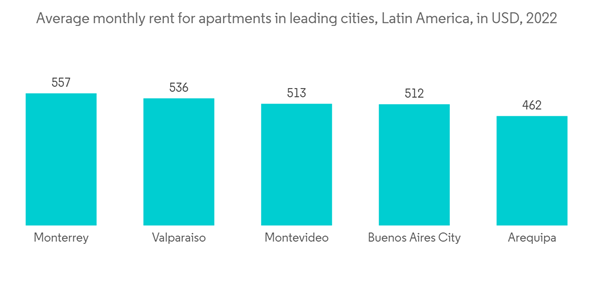Key Highlights
- Destination markets in Mexico are heating up, particularly as remote workers seek a year-round, resort-style living due to flexible, remote work policies. Buyers continue to snap up vacation homes that they can use more frequently and then rent out for income the rest of the year. The global rental market has remained at an all-time high for the past two years as demand continues to outpace supply. Single-family home sales increased by 30%, with the median price increasing by 95%. Condos were the most popular commodity, with transactions increasing by 93%, followed by single-family homes and undeveloped land.
- Polanco, known as the "Beverly Hills of Mexico," is the cultural center of Mexico City, the country's capital, and is home to some of Latin America's most expensive properties. In this region, condos in low-rise buildings are the most common housing type. They are typically designed in the Mexican/international contemporary style. Some of the most prestigious residential projects are boutique-style buildings with 10 or fewer condos and five stories or less. They typically range from 1,500 to 4,000 square feet, which is relatively large compared to condos in other large cities. Many of them have private helicopter landing pads on their rooftops, with the newer condos including a gym, swimming pool, playground, and a shared common area, among other things.
- Playa del Carmen, located on the beautiful Riviera Maya about an hour from Cancun, is becoming increasingly popular among the digital nomad crowd as a fun little beach city. This region is more expensive than Mexico City and, along with Cancun and Tulum, ranks second in Latin America only to Punta del Este in Uruguay. However, unlike other Latin American cities, prices in Mexico City are much more closely linked to the North American market, as this is the primary target market for the Mexican industrialists, who are tied to the American economy.
- The rent of apartments in Mexico City is significantly lower than in many other countries. Tourist attractions or major economic centers are located in cities with the most expensive housing. As a result, rent is relatively more expensive in Los Cabos, Monterrey, Guadalajara, and Cancun. On the other hand, Tlaxcala, Zacatecas, and Tepic are several cities with the lowest prices.
Latin America Condominiums and Apartments Market Trends
Increasing Sales of Apartments Driving the Market
According to government and industry figures, Colombia's supply of urban housing has been increasing. However, it has not been sufficient to offset demand. According to official statistics, the country's housing stock is more than 1.3 million homes short. To meet demand, the government has implemented policies that encourage and subsidize construction and housing investment. Colombia is experiencing the region's fastest-growing construction boom. Some companies are helping solve the problem, with La Haus from Medelln obtaining more than USD 158 million from investors. La Haus stated that its latest round would enable it to help solve Latin America's extreme real estate inequality by bringing liquidity to real estate developers and customers.Luis da Silva, Brazil's newly re-elected president, announced plans to revive the housing finance program established during his previous term as a key pillar of his new administration's goals. Brazil currently has a housing deficit of more than 5 million homes. Affluent buyers in both of Brazil's largest cities have preferred luxury apartments. In Sao Paulo, sales of apartments priced above BRL 2 million (approximately USD 390,000) increased by 3.2% in the year ending June 2021. The increase was even greater in Rio de Janeiro, where transactions increased by 10%.
Further, according to a study conducted by Colombian startup La Haus, Mexico may need to invest nearly 4% of its GDP each year for the next two decades to fulfill the demand for residential real estate. In Mexico, the demand for housing is increasing while the number of people living together is decreasing. Several homes in Mexico may also need to be replaced in the coming years because, according to Mexico's national statistics agency, 57% of homes were built by their owners, many of which do not meet building codes.
Increasing Demand for Luxury Condominiums
Polanco, known as the "Beverly Hills of Mexico," is the cultural center of Mexico City, the country's capital, and is home to some of Latin America's most expensive properties. According to Mexico Sotheby's International Realty, the general price range for luxury housing is USD 6,000-USD 12,000 per square meter. Single-family mansions from the 1950s and 1960s, which are extremely rare, sell for between USD 12 million and USD 15 million. Most of them have been transformed into restaurants, hotels, offices, and shopping malls.Los Cabos is located on the southernmost tip of Mexico's Baja California peninsula, in Baja California Sur. It has become one of the most sought-after markets for exclusive second homes, particularly among high-net-worth individuals from the neighboring United States and other wealthy buyers from across the world. Demand increased sharply in 2021, implying that the time to market for property listings is becoming increasingly short while prices continue to rise. A luxury property in Los Cabos costs an average of USD 3.1 million. A luxury condominium will cost around USD 1.5 million, whereas a single-family home will cost around USD 4.3 million. The National Association of Realtors identified Argentines (13% of all buyers) as the top Latin American customers in southern Florida for 2021, followed by Colombians (12%), Venezuelans (10%), and Mexicans (7%).
Latin America Condominiums and Apartments Industry Overview
The Latin American condominiums and apartments market is fragmented with the presence of a large number of local and regional players, as well as global players. The major players include Tishman Speyer, Hines Group, JLL, CBRE, and Greystar Real Estate Partners. The market is driven by collaborations between companies to amplify the supply of this real estate. Local start-ups are also entering the market to provide services in this segment, creating competitiveness in the market.Additional Benefits:
- The market estimate (ME) sheet in Excel format
- 3 months of analyst support
This product will be delivered within 2 business days.
Table of Contents
1 INTRODUCTION1.1 Study Assumptions
1.2 Scope of the Study
2 RESEARCH METHODOLOGY
2.1 Analysis Method
2.2 Research Phases
3 EXECUTIVE SUMMARY
4 MARKET INSIGHTS
4.1 Current Market Scenario
4.2 Value Chain/Supply Chain Analysis
4.3 Residential Real Estate Buying Trends - Socioeconomic and Demographic Insights
4.4 Government Initiatives and Regulatory Aspects Pertaining to the Residential Real Estate Sector
4.5 Insights into the Size of Real Estate Lending and Loan-to-value Trends
4.6 Insights into the Interest Rates for the General Economy and Real Estate Lending
4.7 Insights into the Rental Yields in the Residential Real Estate Sector
4.8 Impact of COVID-19 on the Market
5 MARKET DYNAMICS
5.1 Market Overview
5.2 Market Dynamics
5.2.1 Drivers
5.2.2 Restraints
5.2.3 Opportunities
5.3 Industry Attractiveness - Porter's Five Forces Analysis
5.3.1 Threat of New Entrants
5.3.2 Bargaining Power of Buyers/Consumers
5.3.3 Bargaining Power of Suppliers
5.3.4 Threat of Substitute Products
5.3.5 Intensity of Competitive Rivalry
6 MARKET SEGMENTATION
6.1 By Country
6.1.1 Mexico
6.1.2 Brazil
6.1.3 Colombia
6.1.4 Rest of Latin America
7 COMPETITIVE LANDSCAPE
7.1 Overview
7.2 Company Profiles
7.2.1 Tishman Speyer
7.2.2 Hines Group
7.2.3 JLL
7.2.4 CBRE
7.2.5 Greystar Real Estate Partners
7.2.6 Mrv Engenharia e Participacoes SA
7.2.7 Homex
7.2.8 Consorcio ARA
7.2.9 CARSO GROUP
7.2.10 Desarrollos Inmobiliarios Sadasi SA de CV
7.2.11 Beacon Capital Partners
7.2.12 Invitation Homes
7.2.13 Howard Hughes Corporation*
8 FUTURE OF THE MARKET
9 APPENDIX
9.1 Marcroeconomic Indicators (GDP Breakdown by Sector, Contribution of Construction to Economy, etc.)
9.2 Key Production, Consumption, and Export and Import Statistics of Construction Materials
Companies Mentioned (Partial List)
A selection of companies mentioned in this report includes, but is not limited to:
- Tishman Speyer
- Hines Group
- JLL
- CBRE
- Greystar Real Estate Partners
- Mrv Engenharia e Participacoes SA
- Homex
- Consorcio ARA
- CARSO GROUP
- Desarrollos Inmobiliarios Sadasi SA de CV
- Beacon Capital Partners
- Invitation Homes
- Howard Hughes Corporation*










